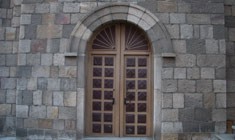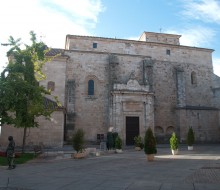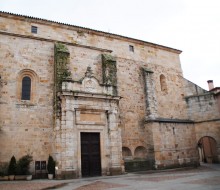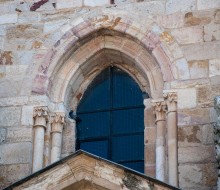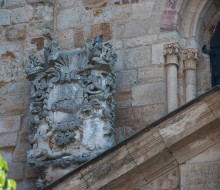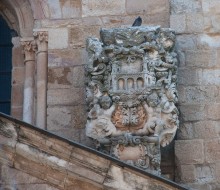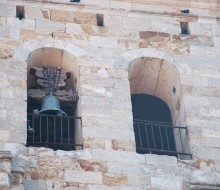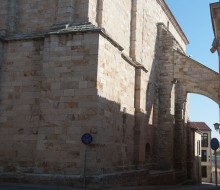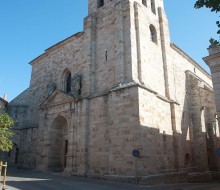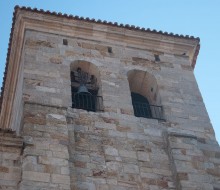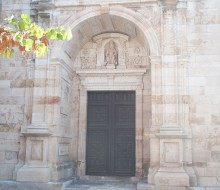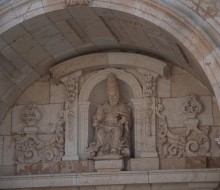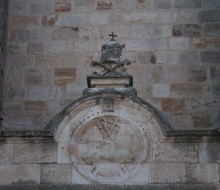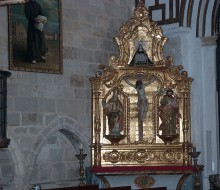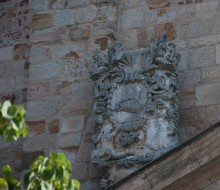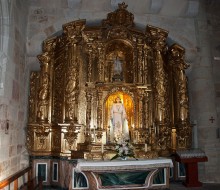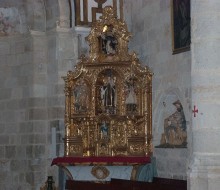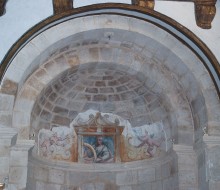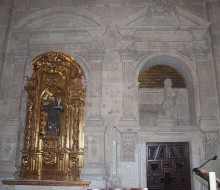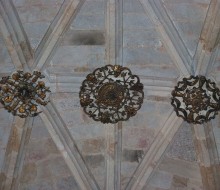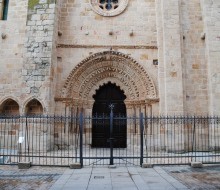Church of San Ildefonso
Zamora
Church of San Ildefonso
Zamora12th century
It was raised on a Visigothic church. This church construction begun in Romanesque style in the 21th century. In this style were built the doorway, the main chapel, a rosette and the southern wall, which was renovated during the 15th century with a cover based on Gothic vaults.
Ferdinand I of León and Castile ordered that it was built over the former Visigothic church of Santa Leocacia. In the 12th and 13th century, it was enlarged and renovated, and in the 15th century was modified. Only some things remain from what it was Romanesque originally: the southern wall, part of the northern one, the central semicircular apse, the gable end, the northern doorway located behind the current neoclassical and the southern doorway. Its original floor plan changed from having three naves and three apses, to a single covered with a single ribbed vault and a semicircular apse, for which was necessary to add two flying buttresses.
Between 1719 and 1723 the inner part was repaired, the tower was renovated and the western doorway was built. Northern doorway was built in the late 18th century though. Well-lit Gothic vaults belong to the late 15th century. The Cardinal Bishop of Zamora ordered their construction. And next to the Main Chapel is the Chapel of the Immaculate, built in 1678 in Baroque style and used as a pantheon. In the sacristy is preserved a 16th-century Flemish triptych.
On the outside there are solid volumes where Romanesque elements protrude. A Romanesque tower altered with Baroque elements stands at the foot of the building and in the middle of the western front there is a St. Peter sculpture and the two base parts of the city shield.
The main baroque doorway, date from the 18th century. Southern doorway remains in a Romanesque style. In fact, at the heading part of the church, there is a Romanesque apse. It is inspired by the doorway called “Puerta del Obispo”of the Cathedral.
It houses the remains of San Ildefonso (St. Ildephonsus) and San Atilano, a monk from Moreruela, who was bishop of Zamora and patron saint of the city.
In 1500, Don Juan de Aguilar declared it an Archpriest's Church and it became part of the list of National Monuments in 1974.
Exterior de la Iglesia de San Ildefonso
En el exterior se muestran volúmenes macizos en los que sobresalen elementos románicos. La portada principal es barroca, del siglo XVIII y la portada de la zona sur se conserva románica, de hecho, sobresale en la cabecera un ábside de esa época. Está inspirada en la portada del obispo de la catedral.
A los pies del edificio se levanta una torre de origen románico alterada con elementos barrocos y en la fachada oeste hay una escultura de San Pedro en el medio y a cada lado dos cuarteles del escudo de la ciudad.
Interior de la Iglesia de San Ildefonso
Entre 1719 y 1723 se reparó el interior, se reformó la torre y se construyó la portada occidental y a finales del siglo XVIII se construyó la portada norte. Las bóvedas góticas, de gran luz, son de los últimos años del siglo XV, edificadas por orden del obispo-cardenal de Zamora.
Al lado de la Capilla Mayor se encuentra la Capilla de la Inmaculada, mandada construir en 1678 en estilo barroco como panteón y en la sacristía se conserva un tríptico flamenco del siglo XVI.
GET DIRECTIONS
ROUTES
OPENING HOURS AND VISITS
From 1st October until 1st March:
From Tuesday until Sunday: from 10:00 to 14:00 and from 16:30 to 18:30.
Closed on Monday.
From 1st March until 30th September:
From Tuesday to Sunday: from 10:00 to 13:00 and from 17:00 to 20:00.
Closed on Monday.
GENERAL INTEREST SERVICES
Tourist offices:
- Local tourist office: It is located at 5, Arias Gonzalo Square. Tel. +34 980 533 694
- Castilla y León tourist office: It is located at 1, Príncipe de Asturias Avenue. Tel. +34 980 531 845
- Provincial tourist office: It is located at Viriato Square. Tel. +34 980 534 047
Local police: Tel. +34 980 531 245
Civil Guard (police with responsibilities outside towns): Tel. +34 980 521 100
Emergency telephone numbers: 112
- Virgen de la Concha (Hospital): Tel. +34 980 548 212
Bus station: Tel. +34 980 521 281
Train station: Tel. +34 980 521 110
Taxi: Tel. +34 630 630 630
Civil defence: Tel. +34 980 536 190
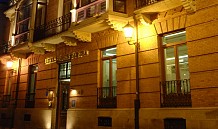
Hotel Horus
Zamora
El Hotel Horus, abierto en el año 2001, tiene un total de treinta y ocho habitaciones dobles que se dividen entre cuatro…
More info